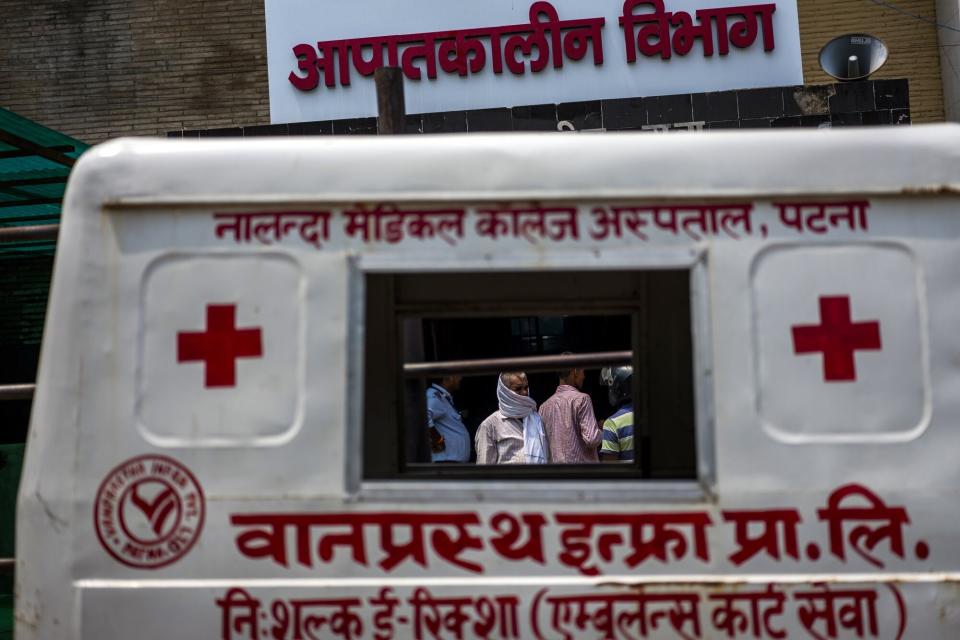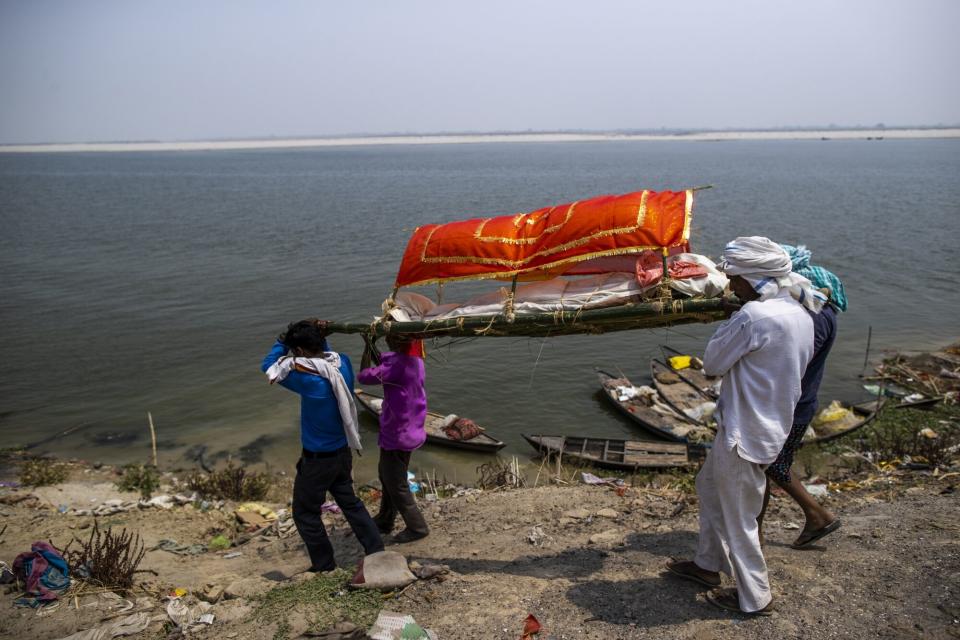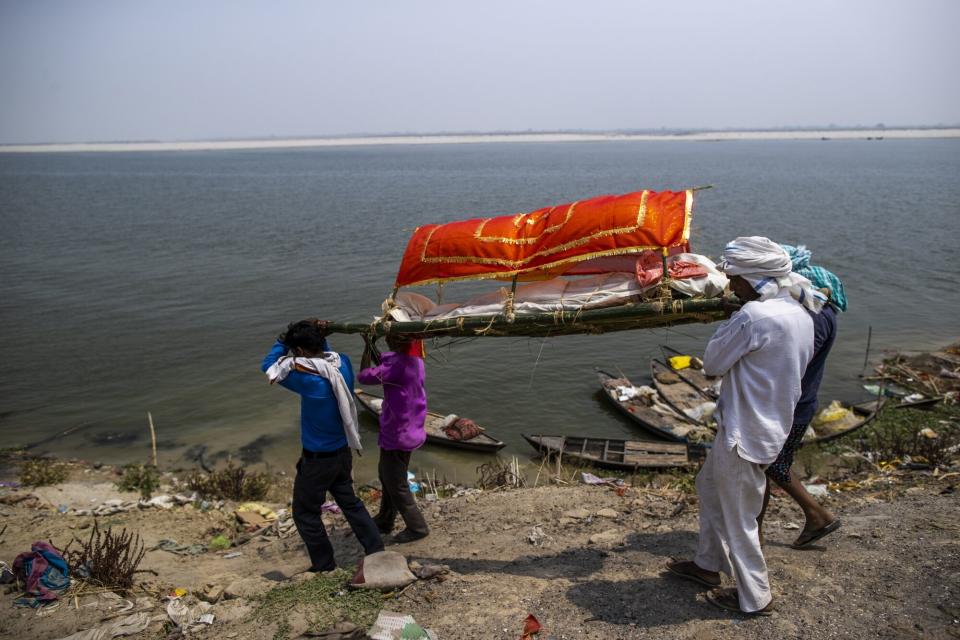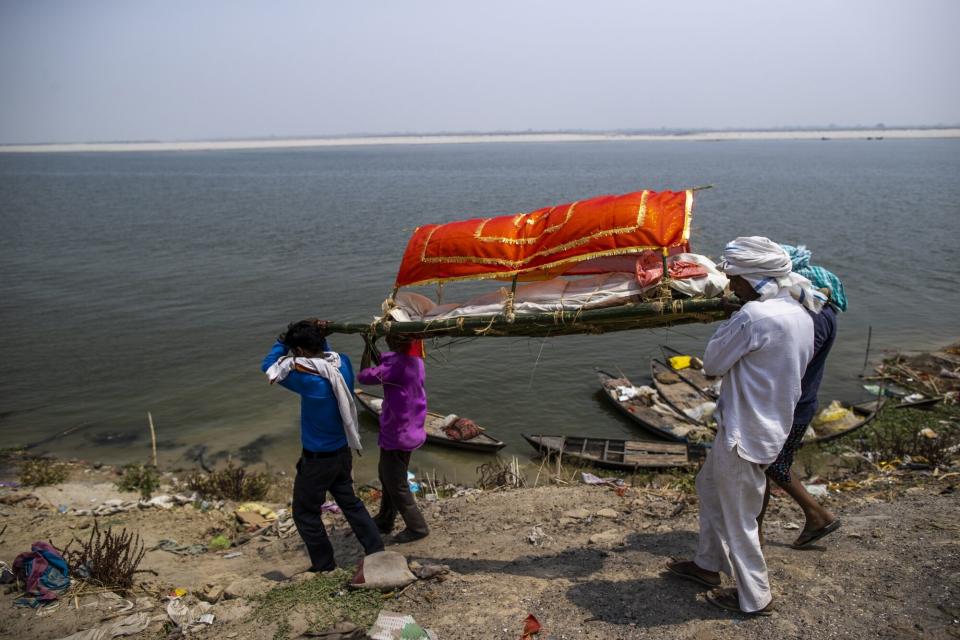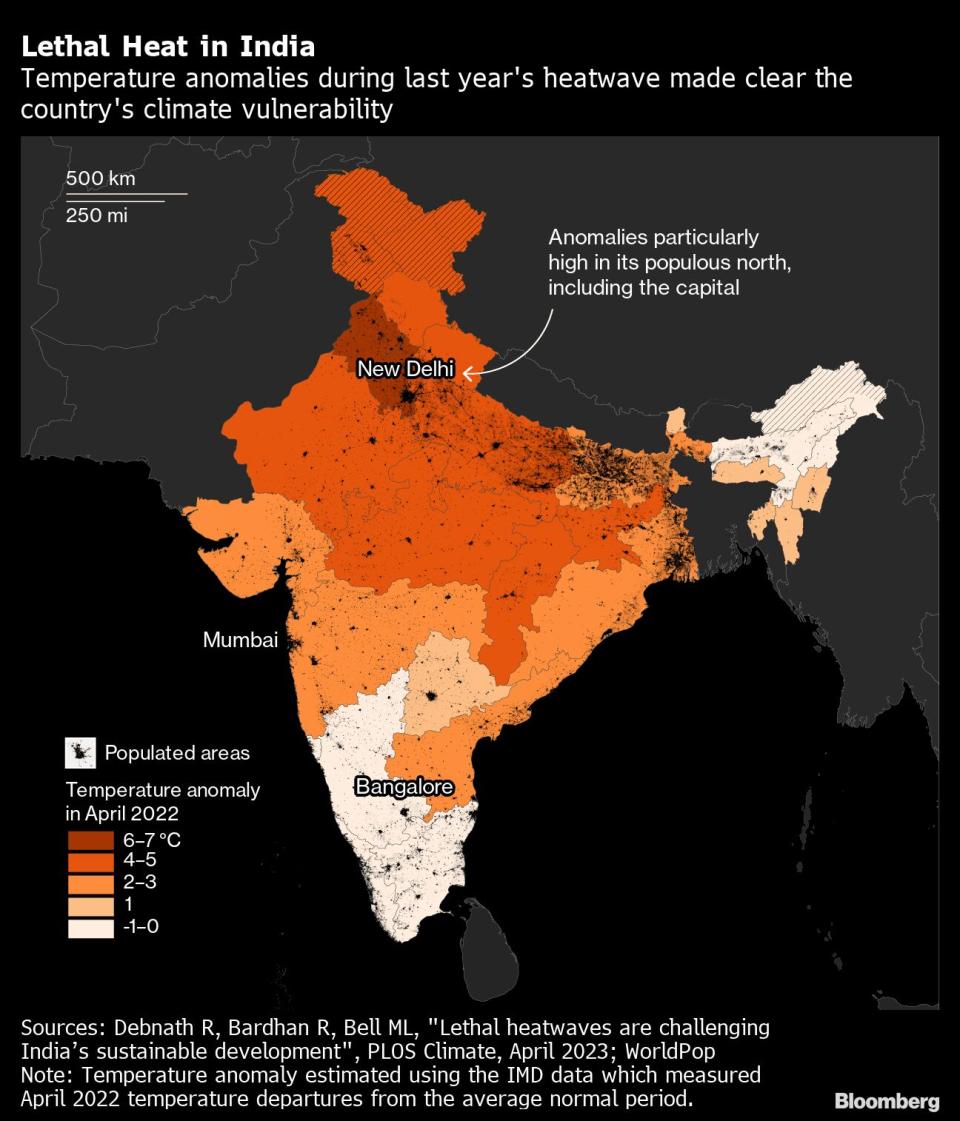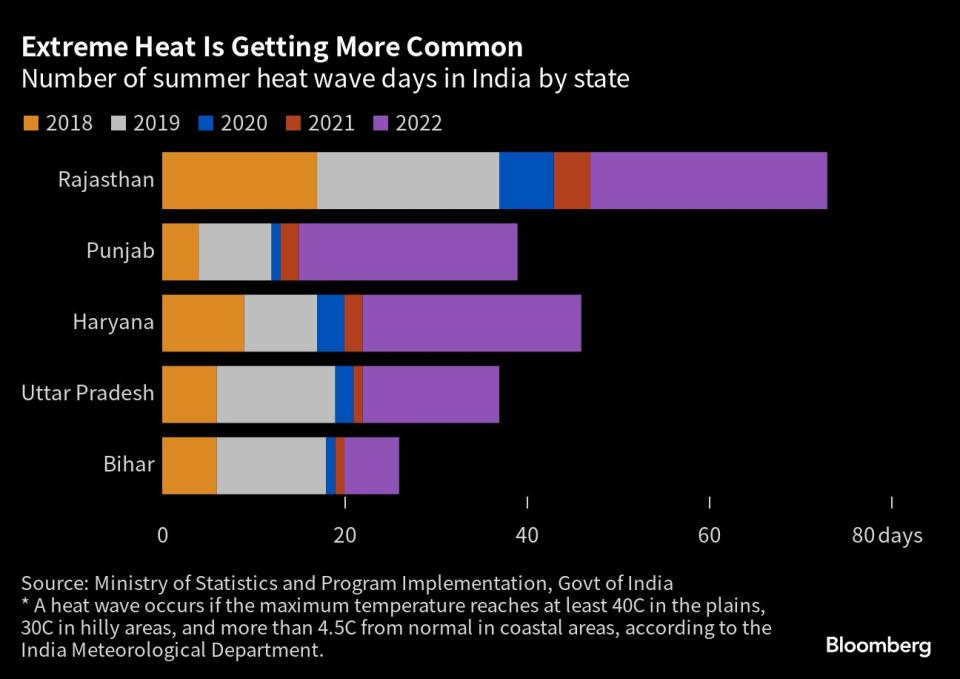India’s June Heat Wave Deaths Are a Harbinger of Worse to Come
(Bloomberg) -- At a cremation ground on the banks of the Ganges river in Ballia, a district in the northern Indian state of Uttar Pradesh, head priest Pappu Pandey says he’s never experienced anything like the last few weeks.
Most Read from Bloomberg
Student Loan-Relief Backers Warn Biden ‘Failure Isn’t an Option’
Wagner Chief Lands in Belarus as Putin Says ‘Civil War’ Averted
Pickleball Injuries May Cost Americans Nearly $400 Million This Year, According to UBS
One of his jobs is to keep a count of bodies. As a vicious combination of extreme heat and punishing pre-monsoon humidity blanketed the region, the ground became choked with pyres. Pandey says deaths doubled to nearly 50 a day at the peak of the heat wave in mid-June — numbers he’s not seen in 20 years at the site outside the Covid pandemic.
“It was like a divine curse,” Pandey said, describing the deadly spell of heat.
June’s sweltering weather, where the mercury soared as high as 46C (115F), is likely just a foretaste of what is to come. Scientists estimate climate change has made extreme heat 30 times more likely in India and the World Bank has flagged India is likely to be one of the first places in the world where heat waves breach the human survivability threshold.
As such, the numerous anecdotal reports of a spike in deaths among the most vulnerable in society have heightened concerns about both central and local government preparations. As well as the human cost, failure to truly tackle the challenges of new-look summer heat comes with a risk to India’s powerhouse economy. McKinsey Global Institute estimates that the lost labor from work in areas exposed to extreme heat, such as construction and agriculture, could put at risk up to 4.5% of India’s GDP by 2030.
“I have never seen such kind of heat in my entire life time,” said C.P. Thakur, 91, a physician and former health minister of the country. “It is worrying that so many people have died.”
Disputed Fatalities
Just how many people have died because of the extreme heat is controversial. Add up estimates from local nonprofit groups and medical officials not authorized to talk to the media, and you quickly get into the hundreds. Ask government representatives, and the numbers dwindle to just a handful. Health authorities have resisted directly connecting the weather with deaths, pointing instead to people’s ages and pre-existing conditions.
One practical problem is that deaths may have multiple causes, said Ronita Bardhan, associate professor of sustainable built environment, University of Cambridge. If somebody with an underlying health condition like diabetes, which makes them more prone to dehydration and hence more vulnerable, dies on a day of 45C temperatures, was it diabetes or the heat that killed them?
“It is very challenging to establish a direct correlation between deaths and extreme heat as there is no diagnostic test for heatstroke,” Bardhan said.
Complicating the issue in India is that less than a fifth of deaths are certified by a medical professional, a step considered routine in most wealthy countries. In Bihar, one of the epicenters of the recent heat wave, the government estimates just 52% of deaths were even recorded in 2019. That means the common statistical technique of measuring excess deaths as deviations from a baseline is fraught with problems.
Even with these limitations, official figures suggests more than 11,000 people died from heat stroke between 2012 and 2021, according to National Crime Records Bureau data.
READ: India Doesn't Know How Many Die in Heat Waves
Heat waves also hurt the poor, who are least likely to be recorded in the statistics, disproportionately more. Many work outside, don’t have access to well-ventilated housing or air conditioning and worry that visiting a hospital will lose them income and savings.
Sree Ram, 55, a mason in Bharauli village about 35 kilometers (22 miles) from Ballia city fell sick in early June after working in the heat. He makes 500 rupees ($6) daily. When the heat became unbearable, he decided to take a few days off — a heavy financial burden for his family. Many others decided they couldn’t, and were the most common victims of the sweltering summer, according to doctors and health officials who asked not to be named as they were not authorized to talk to the media.
Questions of Preparedness
There is no agreement whether such tragedies were a consequence of inadequate preparation, lack of execution, general under-investment in health care or simply the daunting challenges of the situation.
It’s been a brutally hot year across Asia, with maximum temperature records tumbling from Singapore to Vietnam. India saw its hottest February since 1901 and forecasters had flagged the coming high heat and humidity well in advance. India has seen maximum temperatures reach above 45C for at least eight consecutive years through 2023, weather department data shows.
In March Prime Minister Narendra Modi chaired a high-level meeting to review preparations for hot weather conditions and ordered officials to produce accessible information material. And many states and districts have heat action plans detailing both preparations and responses. Standard operating procedures in Uttar Pradesh’s case are detailed enough to assign responsibility for providing shade for stray animals.
Yet local media have reported on medical facilities overwhelmed by a surge in patients suffering from high fever and diarrhea – common symptoms of heat stroke — and of spotty power supplies as the grid struggled to cope with the surge in demand.
In Bihar local people told Bloomberg the heat alerts by the government were erratic. While some said they had received an occasional text message in April or May, most said such text message alerts became more frequent only after the heat peaked and patients had started dying in hospitals.
Local officials reject any suggestion they have been caught out. Ravindra Kumar, the district magistrate in Ballia, said authorities have a tried-and-tested warning system that is followed every year for all natural calamities.
Ranjeet Kumar, chief health surveillance officer for Bihar, said they started alerting people about heat protection in March and made ample preparations in the hospitals.
“People too are well aware of these do's and don'ts,” Kumar said by phone. “But they have to step out for work.”
One of the few places in India where there is any mechanism for day labourers to recoup earnings if they heed advice to stay inside is in the western city of Ahmedabad. A pilot project there is experimenting with an insurance scheme where women can receive payouts whenever heat makes it impossible to work outdoors. It’s funded by the Adrienne Arsht-Rockefeller Foundation Resilience Center.
READ: An Indian City’s Battle Against Extreme Heat
A key question is whether the heat plans are proactive enough. When researchers at the Centre for Policy Research in New Delhi reviewed 37 such plans in a report, they found significant gaps. Only about a third discussed funding sources. Few identified vulnerable populations and how to target resources. Most weren’t statutory documents so lack clear legal authority.
“Heat waves have historically received less attention compared to other disasters,” said Aditi Madan, associate fellow at the Institute for Human Development. While the plans demonstrate progress, the recent fatalities should “serve as a stark reminder of the necessity for proactive measures by the government, indicating the gap between planning and implementation of HAPs.”
Top bureaucrats in the health departments in Uttar Pradesh and Bihar didn't respond to multiple interview requests. In the central government, spokespeople at the home and health ministries didn’t respond to email and phone requests for comment.
Political Will
While national elections are slated for next summer, historically natural disasters and other public health crises have had limited consequence at the ballot box.
Consider India’s ferocious second Covid wave in 2021, which saw cases cross 400,000 a day at the peak, overwhelming hospitals and crematoriums and forcing people to beg for oxygen. Modi was blamed by the opposition for not doing enough to protect lives, yet his Bharatiya Janata Party retained Uttar Pradesh, the country’s most populous state, in assembly elections in March 2022.
There can also be a sense of fatalism. One myth in Indian political discourse that scientists say must be dispelled is the idea it’s always been a hot country and Indians are more resilient to heat than people elsewhere.
Yet the risks of not allocating more resources may change as extreme heat gets more common and more cities start to experience dangerous summer highs. The planet has been scorched by eight of the warmest years on record and last year, temperatures in the country hit as high as 49C, close to the all-time record of 51C seen in 2016.
In its report on heat action plans, the CPR thinktank said by 2050, as many as 24 urban centres are projected to breach average summer highs of at least 35C.
“Many places that need to have local heat action plans do not have one,” said Aditya Pillai, lead author of the report. He notes that among the cities not to have published comprehensive plans are many of India’s biggest metropolitan areas — and drivers of its economy — like Chennai, Mumbai and Delhi.
--With assistance from Sreeja Biswas, Pratik Parija, Atul Prakash and Spe Chen.
(Adds historic heat data in 15th paragraph.A previous version corrected the Indian temperature record in 29th paragraph.)
Most Read from Bloomberg Businessweek
The World’s Empty Office Buildings Have Become a Debt Time Bomb
The Ad Industry Has No Intention of Letting AI Ruin the Party
The ‘Extend and Pretend’ Real Estate Strategy Is Running Out of Time
Race-Based Affirmative Action Is Over. Corporate Diversity Could Be Next
©2023 Bloomberg L.P.

